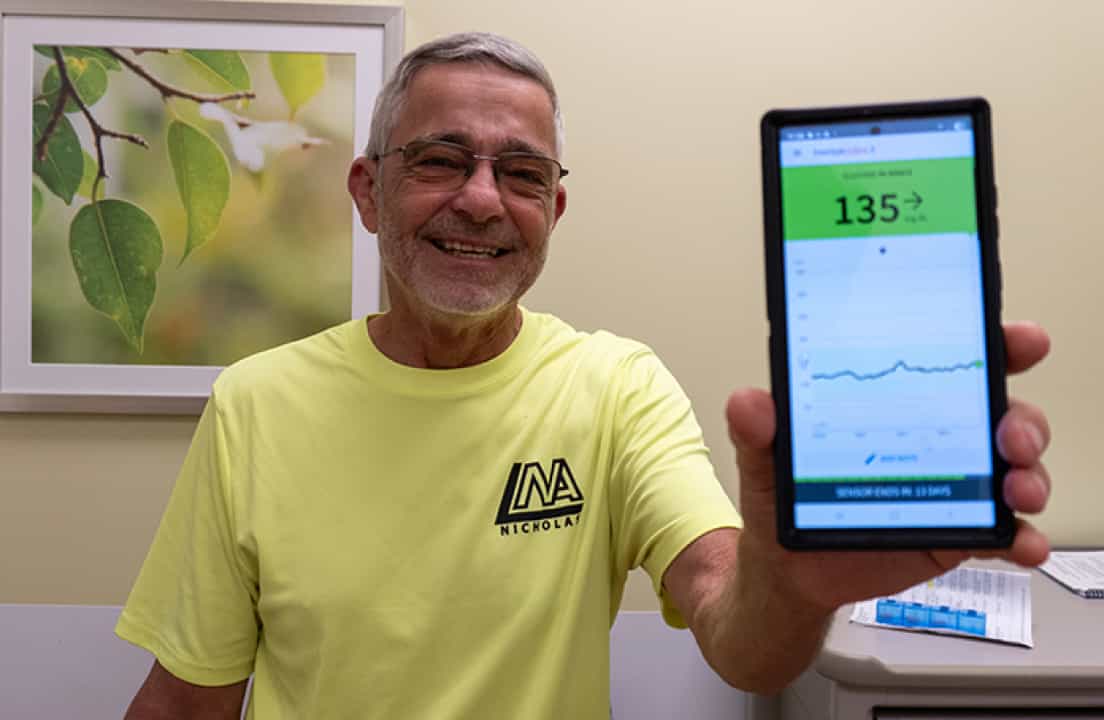T1D Guide
T1D Strong News
Personal Stories
Resources
T1D Misdiagnosis
T1D Early Detection
Research/Clinical Trials
Type 1’s Best Friend: Understanding Diabetic Alert Dogs
Diabetic alert dogs are trained using advanced scent detection methods for a variety of life-saving tasks. Discover how these specially trained pups not only detect blood sugar changes but also offer emotional companionship, enhancing the lives of those with type 1 diabetes.

Since insulin was first invented in 1921, science and technology have grown significantly related to managing blood sugar in people with type 1 diabetes (T1D). From continuous glucose monitors (CGM) like the Dexcom or Freestyle Libre to tubeless pumps like the Omnipod, diabetes tech has grown and continues to grow.
But, for some T1Ds, relying solely on these technical advancements can fall short of their specific needs, and they may be searching for alternative options to help manage their condition. Perhaps they want an option with more humanity, gentleness, or even fur.
Today, we are breaking down everything there is to learn about diabetic alert dogs—pups specifically trained to support individuals with type 1 diabetes in all ways they can.
Diabetes Super Dog Training
According to Diabetic Alert Dogs of America, their dogs are trained using the same methods as the Federal Bureau of Investigation (FBI) and the Bureau of Alcohol, Tobacco, Firearms and Explosives (ATF) to train scent detection in dogs. But, instead of searching for anything potentially criminal, these pups are here to sniff out their owner’s blood glucose (sugar) levels.
Diabetic alert dogs are trained to detect a change in smell from their owner, indicating lower or higher blood sugar levels than normal. This way, the dog can alert their owner and let them know something is wrong, whether that means taking some insulin for hyperglycemia (high blood sugar) or getting a sugary snack to avert hypoglycemia (low blood sugar).

Dog’s Olfactory Power
You and I could probably never smell the difference between high and low blood sugar, but our furry friends can. Dogs have an incredible sense of smell. They are believed to be able to smell a change in their owner's blood sugar levels by recognizing changes in the scent of sweat or saliva.
The American Diabetes Association (ADA) proposed a theory in the Diabetes Care Journal on how dogs detect blood sugar levels surrounding the compound isoprene—a volatile organic compound (VOC) that rises significantly in the breath of someone experiencing hypoglycemia.
Researchers found that hypoglycemia significantly raises the presence of isoprene (found in breath). While it is unclear if this is exactly what diabetic alert dogs recognize, it is the most notable compound to increase when patients are hypoglycemic.
Responsibilities of a Diabetic Alert Dog
Depending on the individual’s needs, a diabetic alert dog can be trained to perform a variety of responsibilities. Most importantly, for people with type 1 diabetes, diabetic alert service dogs are trained to detect low or high blood sugar. They can even carry sugary foods or insulin in their harnesses, making medical supplies quick and convenient.
Diabetic alert service dogs can be trained to complete different tasks besides recognizing and alerting to blood sugar levels.
Assist with Balance
For some T1Ds, high or low blood sugar levels can interrupt a person’s balance, and dogs can be trained to brace their owners and support them if and when they feel unsteady. Some dogs can also be instructed alongside specific technology that can help to assist their owners during an emergency. Little Angels Service Dogs, a service dog training group, trains diabetic alert dogs to interact with a button that, when pressed, sends an automated alert to five pre-determined phone numbers.

Finding Your Diabetes Service Dog
A few different routes and options exist when getting a diabetic alert service dog. To qualify for a diabetic alert dog, you must have some form of diabetes, either type 1, type 2, or even gestational. Dogs4Diabetics, a branch of the National Institute for Canine Service and Training, is the oldest accredited service dog provider for people with diabetes. Workshops about how to get a dog are available on their website.
Many groups train and provide diabetic alert dogs, including Diabetic Alert Dogs of America, Little Angels Service Dogs, and the Ron Santo Foundation. The Ron and Vicki Santo Diabetic Alert Dog Foundation's mission is to education people about the availability and efficacy of diabetic alert dogs.

Additionally, pet owners may consider getting their dogs trained by accredited professionals. Groups like Service Dog Training International can offer teaching courses so your pet can learn the commands it needs to best support someone with diabetes.
The Cost of Diabetes Service Dogs
Due to the extensive training involved in preparing diabetic alert dogs for service, adopting a dog can be quite pricey. Additionally, service animals are not typically covered by most insurance, including Medicare and Medicaid.
The price of a dog can range from $8,000 to $20,000, but certain groups can provide dogs to patients for free if they meet certain criteria.
Diabetic Alert Dogs: Truth or Hype
A recent study conducted for the scientific journal Public Library of Science (PLOS), reviewed 27 diabetic service dogs and their abilities and found that the dogs were responsive to about 83% of the hypoglycemic episodes and 67% of the hyperglycemic episodes.
While these numbers aren’t bad, they are lower than the accuracy of a CGM, which is about 95% accurate, with an exact reading within a 20% margin of actual blood sugar levels.
But while dogs might not be as accurate as a CGM on paper, people who have diabetic alert dogs cite a level of support from the dog that CGMs just don’t match.
Many owners express an additional comfort that comes with having a diabetic-alert dog—not just as a method of controlling and knowing blood sugar levels but as a friend who can support them in more ways than one. While we might not know too much about the science of sniffing out blood sugar, we do know how dogs can affect human beings.

Dogs can be man’s best friend to nearly anyone, but for people living with chronic illnesses such as type 1 diabetes, dogs can also increase psychological and emotional functioning, both from being trained to complete certain tasks and from acting as a companion. For some, dogs can act as nonjudgmental supporters, sitting or walking by your side as you tackle the huge journey of living with a chronic illness.
For more information about whether you might benefit from a diabetic alert dog, communicate with your endocrinologist and medical team to determine what services work best for you.


.webp)





.webp)

.jpeg)
.jpg)
.webp)






.jpg)

.jpg)



.jpg)

.jpg)




.jpg)
.jpg)
.jpg)
.jpg)
.jpg)
.jpg)
.jpg)

.jpg)
.jpg)

.jpg)



.jpg)
.jpg)
.jpg)

.jpg)

.jpg)














.jpg)


.jpg)


















.webp)



















.webp)












.webp)